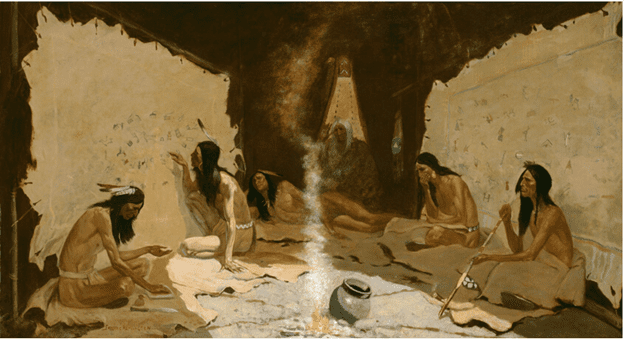The historical process of colonization was well-known and understood to be a violent conquest of mankind and the land that they lived in. Given that the violence of colonialism is obvious even in the rudimentary presentation of a nation or community’s past, museums have long been guilty of ignoring the violence of empire. Colonialism-related cultural art can be found in the narratives of repression, insurrection, religious and ethnic conflict, as well as catastrophic occurrences. By framing the violence in this way, colonialism displaces history onto the colonized and undervalues the endemic violence in addition to the various forms of violence it employed.
Historians of the Tribe by Frederic Remington (1861) Oil on canvas. 62.2 × 111.4 cm (24 1/4 × 43 7/8 in.).

Visiting the Art Institute of Chicago, the painting Historians of the Tribe by Frederic Remington (1861) offers a scenario of the hieroglyphic history of colonial violence that existed in America. The painting features the image of five young Native American men painting a winter count within an Indian interior. The tribal elder lays in the center of the background as he observes the pictorial symbols that are a record of the year’s history, which is now being passed on a tanned animal skin. The historians of the tribe are situated within the glory of the history of the Native American people. It is a representation of a tightly defined and darkened view of the colonial history of the Native American people and their violent experiences.
During the colonial era, the Native Americans opposed attempts by the colonialists to expand their territory and assert their dominance. However, they found it difficult to do so because of the many problems caused by the expanding population of Europe. The native Americans’ attempts to overthrow the colonial masters through diplomacy, battle or even alliances proved ineffective. However, there is a portion of Native Americans’ experiences that are not unique to their history and are depicted through art. The painting thereby becomes an illustration of how colonial vehemence has been written out of the past of the Native American’s past. Merand Roberts (2022) notes that the violence of the European colonialization including the slave trade does constitute a common history of Asia, Africa, middle east in addition to the American hemisphere. The museum’s representation of Native American art concerning colonialism shows that there is a larger and longer history of violence that we witness today.
Remington’s depiction of the Native Americans is created with the subject of sentimentality as it was completed in 1890, the year when the Massacre at the Wounded Knee brought to an end the colonial military conflict with the plains Indians. The glory of the past Americans is well represented. Focus is shifted towards the conversations on provenance and the ideas of conservation. In filing to present such artwork in their original context, museums tend to look the other way and create a process of muzzling that belief in false compassionate colonialism remains prime in America (Heath, 2015). The idea from the painting is that the purpose of the colonialists was not to take property but rather to convey the ideas of the British civilization to people who they thought in need of it. This underlines the American amnesia concerning the nation’s imperial past and how the native people were treated.






